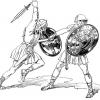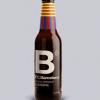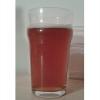-
Postów
494 -
Dołączył
-
Ostatnia wizyta
Aktywność reputacji
-
 BretBeermann otrzymał(a) reputację od xanovich w ilość sutowca do refermentacji keg vs butelki
BretBeermann otrzymał(a) reputację od xanovich w ilość sutowca do refermentacji keg vs butelki
I'm sorry but my Polish is not good enough to adequately answer this question. Maybe someone can translate if you do not understand:
The headspace in a keg is a different percentage of the total volume than the headspace in a bottle. You need to prime a keg appropriately depending on how full it is. Priming for a half-full keg would be different than priming for a 75% full keg and so on. The issue is you need to calculate the required CO2 needed to fill the headspace to the appropriate pressure AND the required CO2 to be in solution to match this at equilibrium for your given temperature. This is dependent on the ratio of headspace to beer. Yeah, you could measure and calculate, but this is a situation best learned by practice than by attempting to solve it theoretically.
-
 BretBeermann otrzymał(a) reputację od koholet w ilość sutowca do refermentacji keg vs butelki
BretBeermann otrzymał(a) reputację od koholet w ilość sutowca do refermentacji keg vs butelki
I'm sorry but my Polish is not good enough to adequately answer this question. Maybe someone can translate if you do not understand:
The headspace in a keg is a different percentage of the total volume than the headspace in a bottle. You need to prime a keg appropriately depending on how full it is. Priming for a half-full keg would be different than priming for a 75% full keg and so on. The issue is you need to calculate the required CO2 needed to fill the headspace to the appropriate pressure AND the required CO2 to be in solution to match this at equilibrium for your given temperature. This is dependent on the ratio of headspace to beer. Yeah, you could measure and calculate, but this is a situation best learned by practice than by attempting to solve it theoretically.
-
 BretBeermann przyznał(a) reputację dla Bielo w Pressure barrel czyli lepsza wersja kegu 5l
BretBeermann przyznał(a) reputację dla Bielo w Pressure barrel czyli lepsza wersja kegu 5l
Nie potrzebujesz wtedy manometru, tzn potrzebujesz ale będzie on na butli. Ciśnienie w kanistrze możesz wtedy sprawdzić poprzez podłączenie butli z reduktorem ustawionym na np. 2 bary lub jakiekolwiek inne, aby tylko wyższe niż w pojemniku [po to, aby piwo Ci się nie cofnęło przez szybkozłączkę do węża gazowego] i natychmiastowe zmniejszanie ciśnienia na reduktorze aż wskazówka przestanie spadać. Odczytana wartość to ciśnienie w kanistrze.
Te plastiki to nie jest to zły pomysł, chociaż kegi 5L też są spoko. Jak dbasz to jakoś bardzo szybko nie rdzewieją. Ponadto nie są jakieś niebotycznie drogie więc po 15-20 użyciach można takiego po prostu wymienić. Tylko trzeba się liczyć z tym, że piwo z takich minikegów po odszpuntowaniu trzeba dosyć szybko wypić.
A już w ogóle najlepszy to jest system cornelius. Ale też najdroższy
-
 BretBeermann otrzymał(a) reputację od bart3q w Beermann's
BretBeermann otrzymał(a) reputację od bart3q w Beermann's
I bottle off of a keg. It takes less time and is cleanlier than using a bottling bucket. If I want to bottle condition, I can still prime in the keg and fill using my setup. It takes me little time, whereas many people find bottling to be a chore.
I begin by setting up my equipment. I've got my things stored in the cellar. It takes me 5 minutes or so to take two trips down and get everything put together.
Sanitizing bottles and putting them on the tree takes a few seconds a bottle. Couple minutes for a whole batch. I keep sanitizer on hand for sanitizing my kegerator, and purging equipment, so there is no need to make a new batch. I use demineralized water from the store (5 L bottles) and add the Star San right into the container, filling my smaller containers from this (stored in the cellar).
I use a carbonator cap and PET bottle with sanitizer to sanitize and purge things, including the beer gun. If you invert the bottle, sanitizer is pushed through the lines. You can leave it sit for 30 seconds, turn the bottle right-side-up and then purge using the CO2 in the headspace. I refill the CO2 pressure in the bottle after a session of filling, but it is enough for all the purging and sanitizing needed before I put things away.
Filling the first bottle causes a bit of foaming, but it is still acceptable and I cap on foam. If it isn't 9 AM like today, then I just drink the first bit to chill the lines down.
The second bottle on look great. No need to chill your bottles, the cold beer and wet glass are enough to keep foaming minimal.
I can close the door on my 3/16 ID line without it pinching the line. I bottle with the door closed.
7 PSI (0,5 bar) isn't too much, and leads to a pretty quick fill.
Carbonation is great, oxidation is minimal, and the beer looks great having come out of the keg, carbonated, without any yeast sediment.
Today's filling session took me under an hour. During this time I:
Got all my gear out
Sanitized what was needed (Caps, Gun, Bottles)
Bottled off a keg
Sanitized the Beer Gun and beer lines in the kegerator
Hooked up a new keg and filled the lines
Cleaned my kegerator interior, countertop, drip tray, and tower
Put all my equipment away
Drank the 250 mL of beer that didn't quite fill a bottle and what was left in the lines
-
 BretBeermann otrzymał(a) reputację od Maciejeq w Beermann's
BretBeermann otrzymał(a) reputację od Maciejeq w Beermann's
I bottle off of a keg. It takes less time and is cleanlier than using a bottling bucket. If I want to bottle condition, I can still prime in the keg and fill using my setup. It takes me little time, whereas many people find bottling to be a chore.
I begin by setting up my equipment. I've got my things stored in the cellar. It takes me 5 minutes or so to take two trips down and get everything put together.
Sanitizing bottles and putting them on the tree takes a few seconds a bottle. Couple minutes for a whole batch. I keep sanitizer on hand for sanitizing my kegerator, and purging equipment, so there is no need to make a new batch. I use demineralized water from the store (5 L bottles) and add the Star San right into the container, filling my smaller containers from this (stored in the cellar).
I use a carbonator cap and PET bottle with sanitizer to sanitize and purge things, including the beer gun. If you invert the bottle, sanitizer is pushed through the lines. You can leave it sit for 30 seconds, turn the bottle right-side-up and then purge using the CO2 in the headspace. I refill the CO2 pressure in the bottle after a session of filling, but it is enough for all the purging and sanitizing needed before I put things away.
Filling the first bottle causes a bit of foaming, but it is still acceptable and I cap on foam. If it isn't 9 AM like today, then I just drink the first bit to chill the lines down.
The second bottle on look great. No need to chill your bottles, the cold beer and wet glass are enough to keep foaming minimal.
I can close the door on my 3/16 ID line without it pinching the line. I bottle with the door closed.
7 PSI (0,5 bar) isn't too much, and leads to a pretty quick fill.
Carbonation is great, oxidation is minimal, and the beer looks great having come out of the keg, carbonated, without any yeast sediment.
Today's filling session took me under an hour. During this time I:
Got all my gear out
Sanitized what was needed (Caps, Gun, Bottles)
Bottled off a keg
Sanitized the Beer Gun and beer lines in the kegerator
Hooked up a new keg and filled the lines
Cleaned my kegerator interior, countertop, drip tray, and tower
Put all my equipment away
Drank the 250 mL of beer that didn't quite fill a bottle and what was left in the lines
-
 BretBeermann otrzymał(a) reputację od Quick.Ben w piwo zeszło niżej niż FFT
BretBeermann otrzymał(a) reputację od Quick.Ben w piwo zeszło niżej niż FFT
Następnym razem uzywać waga do cukru i oddaj do FFT też. Jak jest wiecej cukru w wiadro, jest wiecej alkoholu. Alkoholu ma mniej BLG niż woda, a więc BLG wygląda mniej niż na FFT.
-
 BretBeermann otrzymał(a) reputację od paradox w piwo zeszło niżej niż FFT
BretBeermann otrzymał(a) reputację od paradox w piwo zeszło niżej niż FFT
Następnym razem uzywać waga do cukru i oddaj do FFT też. Jak jest wiecej cukru w wiadro, jest wiecej alkoholu. Alkoholu ma mniej BLG niż woda, a więc BLG wygląda mniej niż na FFT.
-
 BretBeermann przyznał(a) reputację dla bart3q w zacieranie w 56 stopniach
BretBeermann przyznał(a) reputację dla bart3q w zacieranie w 56 stopniach
Nieprawda - zobacz sobie na zakres działania enzymów proeolitycznych.
Jak Charlie wyjaśnia takie postępowanie?
Podejrzewam że chodzi o dobre namoczenie słodu, ustalenie odpowiedniego pH oraz ewentualny czas na korekty, oraz przez to, że tej temperaturze zbytnio enzymy nie są aktywne, uzyskanie powtarzalności procesu zacierania (podgrzewanie itp. zawsze będzie zajmowało mniej więcej tyle samo czasu). Do tego trochę zadziała beta amylaza, co dodatkowo rozluźni nam zacier, i ułatwi podgrzewanie. Ale bardzo jestem ciekawy, czym Charlie to uzasadnia.
-
 BretBeermann otrzymał(a) reputację od Marcin Wojtczuk w Beermann's
BretBeermann otrzymał(a) reputację od Marcin Wojtczuk w Beermann's
Munich Helles #1
16 L Batch Size
2.65 kg Barke Pilsner
250 g Munich I
100 g Melanoiden
25 g Tettnang (60 min)
Saflager 34/70
Brother is visiting and was looking for some German styles, so I decided to make a sessionable version of a Munich Helles. I will come in a bit under the style's gravity (1.038) but it should be a good summer drinker. Mashed for 30 minutes and then double sparged to hit 20 L boil volume. Boiled at a low simmer before dumping hot into a keg and purging it for no-chill.
Brewed 26.06
Will ferment this beer under pressure (aiming for 15 PSI)
Turned out well. Little bit of sulfur early which quickly aged out. Nice drinkable beer which went well for a party my friend was throwing. Most of it got drank a few weeks after brewing.
-
 BretBeermann otrzymał(a) reputację od Marcin Wojtczuk w Beermann's
BretBeermann otrzymał(a) reputację od Marcin Wojtczuk w Beermann's
Equipment:
IKEA Induction Hob
5 Gallon Igloo Cooler with Brew Hardware True Bulkhead, Ball Valve, and Dip Tube
Voille and Organza bags for filtration (can replace dip tube with bazooka tube for vorlauf without bag)
Fridge Fermentation Chamber // Kegerator
3 x 19 L Gallon Fermentation Kegs with Cut Diptube or Floating Diptube
3 x 9 L Gallon Slimline Torpedo Kegs
Custom Hopper on AustinHomebrewSupply DIY Malt Mill Base
22 L Hendi Stainless Stock Pot
12 L Stainless Pressure Cooker for Wort Canning
Homemade Magnetic Stirrer with 2 L Erlenmeyer Flask
Personal Recipes Brewed in Poland:
English Dark Mild #1
Christmas Ale #1
Stout #1
Amber Ale #1
Nut Brown #1
Amber Ale #2
English Dark Mild #2
Imperial Porter #1
Americal Blonde #1
Belgian Dark Strong Ale #1
Amber Ale #3
Hoppy Blonde #1
80 Shilling #1
Wee Heavy #1
Munich Helles #1
Peated Session Lager #1
Munich Dunkel #1
Dry Stout #1
Belgian Blonde with Montmorency Cherries
Festbier #1
Doppelbock #1
Session Dunkel #1
Foreign Extra Stout #1
Belgian Blonde #2
Belgian Single #1
Ordinary Bitter #1
Extra Strong Bitter #1
Northern English Brown #1
English Barleywine #1
Non-alcoholic Ginger Ale #1
American Pale Ale #1
Vienna Lager #1
Rauchmarzen #1
Munich Dunkel #2
Baltic Porter #1
Process Posts:
Bottling Off The Keg
Converting U.S. Shanks for Cobra Tower
Pressure Canning Starter Wort
IKEA Cabinet Kegerator Construction
Recirculating Line Cleaning
-
 BretBeermann otrzymał(a) reputację od Dr2 w bulldog brewer 25l
BretBeermann otrzymał(a) reputację od Dr2 w bulldog brewer 25l
Tak ale to nie ma dużo informacji. Lepiej używac kalkulator jak Brewness, BeerSmith, BrewersFriend na zwykły równan.
-
 BretBeermann otrzymał(a) reputację od buk0 w Dyskusje wolne nt chmielu
BretBeermann otrzymał(a) reputację od buk0 w Dyskusje wolne nt chmielu
Terroir jest bardzo ważne do produkcji chmielu.
-
 BretBeermann otrzymał(a) reputację od bart3q w Dyskusje wolne nt chmielu
BretBeermann otrzymał(a) reputację od bart3q w Dyskusje wolne nt chmielu
Terroir jest bardzo ważne do produkcji chmielu.
-
 BretBeermann przyznał(a) reputację dla dori w Guinness Draught clone (z ekstraktów)
BretBeermann przyznał(a) reputację dla dori w Guinness Draught clone (z ekstraktów)
Co prawda pytanie nie do mnie, ale...
Płatki - teoretycznie nie ma znaczenia, czy zwykłe czy błyskawiczne, ale jeśli masz wybór to weź błyskawiczne. Słód pale ale w recepturze faktycznie jest po to, aby płatki się zatarły, czyli enzymy ze słodu rozłożyły skrobię z płatków i oczywiście swoją własną przy okazji Możesz użyć w tym celu jakiegokolwiek słodu pale ale lub pilzneńskiego.
Udanego piwa życzę
-
 BretBeermann otrzymał(a) reputację od Marcin_K w Fermentatory stożkowe 100l
BretBeermann otrzymał(a) reputację od Marcin_K w Fermentatory stożkowe 100l
You might consider making it so your valve is high enough to empty straight into the keg of your choosing.
-
 BretBeermann otrzymał(a) reputację od CraftMat w RIS z ekstraktów niechmielonych-dobra receptura?
BretBeermann otrzymał(a) reputację od CraftMat w RIS z ekstraktów niechmielonych-dobra receptura?
Jak oddam imbir, robię herbata i spróbowam przed rozlewania. Jest bardzo łatwo używać za dużo imbir. Nigdy nie używałem jabłko w piwie. Ile litrów bedzie?
-
 BretBeermann otrzymał(a) reputację od redlum w Barleywine z ekstraktów niechmielonych. Jakie surowce?
BretBeermann otrzymał(a) reputację od redlum w Barleywine z ekstraktów niechmielonych. Jakie surowce?
NorthernBrewer ma każdy Brewkit w PDFie
http://www.northernbrewer.com/documentation/beerkits/BarleyWine.pdf
http://www.northernbrewer.com/documentation/beerkits/ScottishWeeHeavy.pdf
-
 BretBeermann przyznał(a) reputację dla Pan Łyżwa w HotHead Ale OYL-057
BretBeermann przyznał(a) reputację dla Pan Łyżwa w HotHead Ale OYL-057
Co do tych FM53 , pytałem fermentu o to który to szczep, ale nie odpowiedzieli. ja osobiście obstawiam, że to któryś z poniższych:
Sigmund Gjernes's Voss Kveik
The NCYC found that a sample of Sigmund Gjernes's kveik was made up of three strains of S. cerevisiae. No bacterial contamination was found. DNA fingerprinting found the strains to be closely related [6]. See Larsblog Kveik analysis report for more information.
NCYC 3995 - original sample of kveik containing three strains of S. cerevisiae. NCYC 3996 - 1st isolate in the 3995 blend. NCYC 3997 - 2nd isolate in the 3995 blend. NCYC 3998 - 3rd isolate in the 3995 blend. Fermentum lubi wybierać sprawdzone szczepy, a te z Voss są dostępne w The Yeast Bay oraz w Omega Labs, ale pod numerem 062.
Co do samych Hot Head, na stronie Omega Labs jest oznaczony jako ekskluzywny szczep, co pozwala sądzić, że inni do nie mają.
A tu jeszce taki zabawny filmik z drożdżakami.
Co do ilości szczepów, według Milk The Funk zarejestrowanych jest 20 szczepów i 3 blendy w banku.
-
 BretBeermann otrzymał(a) reputację od bart3q w HotHead Ale OYL-057
BretBeermann otrzymał(a) reputację od bart3q w HotHead Ale OYL-057
Nie Bart3q, jest czysty bez problemów. Jak chcesz, mogę dać fiolkę do ciebie przez pocztę.
-
 BretBeermann otrzymał(a) reputację od dirk gently w Zacieranie przez noc "na słodko"
BretBeermann otrzymał(a) reputację od dirk gently w Zacieranie przez noc "na słodko"
To jest normalny w Stanach. Dużo ludzi zacierają cały noc. Enzymów bedzie aktywny, ale w 62 C to jest dość że ewentualnie będzie denaturowane. Jak nie spadła do temperatura gdzie bakterii są aktywny (może w lodówka turystyczna) będzie dobrze. Nie jest ważne zrobić "mash out", bo bedzie ekstrakcja taniny.
-
 BretBeermann otrzymał(a) reputację od Abstynent w Trzecie pokolenie gęstwy bez przemywania
BretBeermann otrzymał(a) reputację od Abstynent w Trzecie pokolenie gęstwy bez przemywania
Jak masz za dużo drożdze po fermetacji, będzie mniejszy estrów i bedzie "czysty" smak. Jest możliwe że piwo na za dużo drozdze jest "za czysty" i ma smak że nie jest "jak piwo". To jest teoria. Lepiej dac gęstwa do słoik i potem do fermentor.
-
 BretBeermann przyznał(a) reputację dla bart3q w Pytanie do posiadaczy elektrycznych kotłów zacierno-warzelnych.
BretBeermann przyznał(a) reputację dla bart3q w Pytanie do posiadaczy elektrycznych kotłów zacierno-warzelnych.
Twoje obliczenia wskazują na to, że zawsze dzielisz 3500W przez napięcie (220 lub 230V)
A Dr2 pisze, że o ile przy 230V grzałka ma 3500W, to przy 220V już będzie to mniej.
Więc liczenie 3500W/220V= ileśtam amper jest błędne.
-
 BretBeermann otrzymał(a) reputację od dirk gently w Jak zrobić mocne piwo o wiekszej zawartości alkoholu?
BretBeermann otrzymał(a) reputację od dirk gently w Jak zrobić mocne piwo o wiekszej zawartości alkoholu?
To nie prawda. Jak koncentrujesz cukier, jest wiecej IBU ale smak jest proporcja i to jest tak samo.
-
 BretBeermann przyznał(a) reputację dla zasada w Recetura BDSA
BretBeermann przyznał(a) reputację dla zasada w Recetura BDSA
Mam trzy uwagi.
Drożdże: jedna fiolka na taki litraż i takie BLG to za mało. Chyba pisałeś o tym w wątku obok - gęstwa z jakiegoś cienkusza najlepsza.
Chmiele: dałbym go mniej. Wychodzi Ci prawie 50 IBU, ja trzymałbym się widełek stylu: do 35.
Cukier: jak napisał Bret - możesz dać zwykły buraczany. 1 kg na pierwszy rzut oka mnie nieco zaskoczył, ale doczytałem i nie jest źle.
Czytałeś wątek, widziałeś prezentację?
Powodzenia, ja za swoje zabieram się za jakiś czas - miałem tydzień obsuwy w planach warzelniczych.
-
 BretBeermann otrzymał(a) reputację od bart3q w Aktywność enzymów podczas powolnego studzenia odfiltrowanej (i nie warzonej) brzeczki
BretBeermann otrzymał(a) reputację od bart3q w Aktywność enzymów podczas powolnego studzenia odfiltrowanej (i nie warzonej) brzeczki
Enzymów bedzie akytwny jak nie są denaturowane. Aktywność jest bardzo wolno jak jest zimno. Tylko na wysoka temperatura bedą denaturowane. Teraz coś po Angielsku od ekspert enzymów jęczmien:
Firstly, the mash must be heated to around 65°C to achieve a relatively rapid rate of starch gelatinization to enable the DP enzymes to rapidly degrade it. However, at that temperature, depending on amount of solutes (KI, osmolyte conc, etc) and mash thickness, the enzymes (esp b-amylase and limit dextrinase) will denature. When you cool the mash down, depending on when you do it, a proportion or all of these enzymes will already be denatured. However, on cooling (particularly on ice, not sure of other temps), some of the enzymes that may not have been irreversably denatured, may refold (re-nature - JP) returning some of the enzymes activity. This is the difference of the Sd1 type b-amylase thermostability compared to the Sd2H type.
On cooling the mash, why you would bother(?), some enzyme may refold (?). If it is limit dextrinase, it may reattach itself to its inhibitor (?). The DP enzymes will be active at say 15-20°C because barley germinates and grows from the seed at this temperature. The rate of the enzyme action will of course be slower at the lower temperature, and I would not rule out changes in the starch structure that might hinder hydrolysis.











